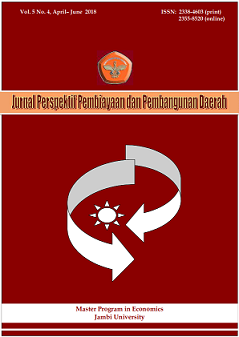State stabilization macroeconomic policy: features and prospects for Ukraine
DOI:
https://doi.org/10.22437/ppd.v5i4.4990Abstract
The research reveals the essence of the process of state stabilization macroeconomic policy, which includes two main directions: fiscal policy influence on the budget balancing and monetary regulation of economy through the transmission mechanism improvement and monetary regime defining. The key problems connected with the state budget deficit are investigated. The state and dynamics of the Ukraine state budget are considered. The ways of overcoming the consequences of state budget imbalances are analyzed. The concept of transmission mechanism was defined. Were shown and explained all the key channels of monetary transmission used in Ukraine and in the world, and were suggested the ways to improve their efficiency, which in future may lead to the improvement of the economic situation in Ukraine. Was justified the necessity of improving the transmission mechanism for the monetary policy strategic objectives achieving. Were given the recommendations on how to improve the channels of transmission mechanism in Ukraine with the aim of increasing the effectiveness of monetary stabilization policy. The basic monetary regimes implementation in various countries of the world and the resulting consequences are researched. The benefits of inflation targeting regime for the state’s monetary policy effectiveness enhancing are justified. Recommendations for further implementation of the inflation targeting regime in Ukraine are provided.
Downloads
References
Andrushchak, Ye.M. & Khar, V.S. (2011). The transmission mechanism of monetary policy in Ukraine. Naukovyi visnyk NLTU Ukrainy, 21(6), 106-113.
Arzhevitin, S.M. (2009). Channels of monetary transmission. Finansy, oblik i audyt, 13, 7-14.
Balastryk, L.O. (2010). Improvement of methods of strategic priorities implementation in the budget policy of the state. Ekonomika ta pidpryiemnytstvo, 24, 20-29.
Bazylevych, V.D., Bazylevych, K.S. and Balastryk, L.O. (2007). Macroeconomics. Kyiv: Znannia.
Danylenko, A.I., Grytsenko, A.A. and Zymovets, V.V. (2010). Fiscal and monetary policy in Ukraine: problems and ways to strengthen the interconnection. Kyiv: Natsionalna akademiia nauk Ukrainy.
Demianyshyn, V. (2009). Budget deficit and its impact on the crisis situation in Ukraine. Visnyk Ternopilskoho derzhavnoho ekonomichnoho universytetu, 5, 120-123.
Dzyublyk, A.V. (2012). Prospects of optimization of the transmission mechanisms of monetary policy in the period of crisis in the financial markets. Finansy, oblik i audyt, 19, 55-64.
Gnativ, A.A. (2009). Inflation targeting as an optimal monetary policy regime in Ukraine. Rehionalna ekonomika, 2, 119-125.
Gordienko, V.P. (2012). Inflation targeting as an effective method of ensuring price stability. Finance and credit activities: the theory and practice problems, 1(2), 15-21.
Gritsenko, A.A. (2008). The institution of inflation targeting: international experience and prospects of introduction in Ukraine. Kyiv: Institute of economics and forecasting of NAS of Ukraine.
Kalinovskyi, R.О. (2017). The rationale for the application of the inflation targeting regime in Ukraine. Baltic Journal of Economic Studies, 3(1_January), 52-57.
Keynes, J.M. (1999). The general theory of employment, interest and money. Moskow: Gelios ARV.
Kolisnyk, O. (2011). Management of budget deficit. Svit finansiv, 3-4, 102-110.
Koncewicz, K.S. (2012). The analysis of regimes of monetary policy in various countries of the world. KROK, 1, 214-216.
Kornev, I.V. (2015). The improving of the monetary policy effectiveness and instruments of its realization in Ukraine. Scientific notes of National University Ostrog Academy, 28, 125-129.
Mashko, A.I. (2010). Management of the state budget deficit. Visnyk Khmelnytskoho natsionalnoho universytetu. Ekonomichni nauky, 5, 152-158.
Mishchenko, I.V., Petryk, A.I., Somyk, A.V., Lysenko, G.S. & others (2008). The monetary transmission mechanism in Ukraine: analytical materials. Kyiv: Tsentr naukovykh doslidzhen Natsionalnoho banku Ukrainy.
Mishchenko, V.I., Somyk, A.V. and Lysenko, G.S. (2010). Peculiarities of action of the transmission mechanism of monetary policy in conditions of crisis. Kyiv: Tsentr naukovykh doslidzhen Natsionalnoho banku Ukrainy.
Papaika, A.A. (2010). World experience of anti-inflationary policy of the state: recommendations for Ukraine. Economics industry, 2, 3-8.
Petlenko, Yu. & Mylovanova, Ye. (2017). Theoretical and methodological aspects of fiscal policy of the state. Visnyk Kyivskoho natsionalnoho universytetu imeni Tarasa Shevchenka. Ekonomika, 1(190), 28-35.
Prushkovskaya, E.V. (2010). Targeting as an aspect of monetary policy in conditions of globalization. Ekonomika ta pidpryiemnytstvo, 3, 141-146.
Radionova, I.F. (2009). Macroeconomics–2. Kyiv: KNEU.
Slipchenko, T.A. (2010). Theoretical analysis of monetary regimes and selection criteria for Ukraine. Naukovyi visnyk NLTU Ukrainy, 20, 232-238.
Slipchenko, T.O. (2011). Directions of monetary transmission optimization under conditions of transitive economy. Naukovyi visnyk NLTU Ukrainy, 21(18), 250-255.
Stelmakh, V.S. (2009). Monetary policy of the National Bank of Ukraine: modern condition and prospects. Kyiv: Tsentr naukovykh doslidzhen Natsionalnoho banku Ukrainy.
Stiglitz, J. (1999). Economics of the public sector [LBook version]. Retrieved from www.twirpx.com
Vishnevska, V.S. (2015). Economic mechanism of inflation targeting in Ukraine. Lviv: NUL.
Implementation of the state budget of Ukraine. (2017, September 18). Retrieved from http://index.minfin.com.ua/budget/
Downloads
Published
How to Cite
Issue
Section
License
Copyright (c) 2018 Roman Kalinovskyi

This work is licensed under a Creative Commons Attribution 4.0 International License.

















